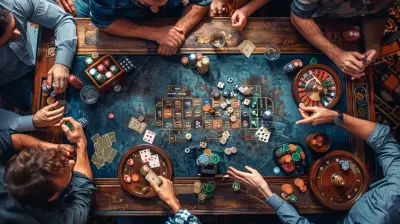Balancing Challenge and Reward Systems for Player Retention
2 September 2025
Games are meant to entertain, engage, and sometimes frustrate—in a good way. But what keeps players logging in day after day or queuing up for just “one more match”? It's not just killer graphics or flashy loot drops. It’s how well a game balances challenge and reward. Get this balance right, and you’ve got a player for life. Miss the mark, and you’ll see your user base vanish faster than loot at the end of a raid.
In this article, we're diving deep into the psychology and mechanics behind balancing challenge and reward systems for player retention. Whether you're a game developer, designer, or just curious about what makes your favorite titles tick, you’re in for a wild ride.
Why Player Retention Matters
Let’s keep it real—getting a player to install your game isn’t the hard part anymore. Holding their attention? That’s the real beast.Retention metrics like Day 1, Day 7, and Day 30 retention give you a snapshot of how engaging your game is over time. A low retention rate screams one thing: players aren’t hooked. And in an industry where free-to-play dominates, long-term engagement is often what separates success from failure.
So, what keeps players coming back for more?
Spoiler alert: it’s not just good content. It’s how that content is delivered through challenges and rewards that feel meaningful and satisfying.
The Psychology Behind Challenge and Reward
Humans are wired to respond to challenges and rewards. It’s baked into our biology. We crave progress, we love achieving goals, and we’re motivated by the prospect of a reward—whether that’s a treasure chest, a level-up, or a shiny weapon skin.The Role of Challenge
Think back to the first time you played a really tough boss level. You probably wanted to rage-quit, but then—after trying a few strategies—you finally beat it. That high? That’s the result of well-balanced difficulty. You were challenged just enough to feel frustrated, but not so much that you gave up entirely.That sweet spot is called "The Flow Channel", where a player’s skill level matches the challenge. Too easy? Boring. Too hard? Rage-quit city.
The Role of Reward
Now let’s talk about goodies. Rewards light up the brain’s dopamine centers. They make us feel accomplished. But here’s the catch: if rewards come too often or too easily, they start to feel empty.Balancing rewards means making sure they’re timed, meaningful, and—this is important—earned.
The Danger of Imbalance
Failing to strike the right balance between challenge and reward can seriously mess with your game’s engagement levels.Too Much Challenge, Not Enough Reward
If players are grinding for hours with little return, frustration starts to outweigh fun. It’s like being stuck in a maze with no cheese at the end. Players eventually burn out and bounce.Too Much Reward, Not Enough Challenge
On the flip side, if every player gets a gold star just for showing up, then there’s no sense of achievement. It’s like handing out trophies before the game even begins. Players want to feel like they've earned something.
Strategies to Balance Challenge and Reward
Alright, let’s break down some practical ways to strike that perfect balance.1. Dynamic Difficulty Adjustment (DDA)
Ever played a game that seems to read your mind and adjust how hard it is? That’s DDA in action.It monitors how well (or poorly) a player is doing and subtly shifts the difficulty to keep them engaged. Think of it as a rubber band that stretches but doesn’t snap.
✅ Pros: Keeps all skill levels engaged.
❌ Cons: Can feel unfair if players sense the game is playing them.
2. Reward Variety
Not every reward needs to be a legendary sword. Mix it up—cosmetics, story unlocks, in-game currency, or even just a cool animation. Variety keeps players guessing and avoids burnout.Also, think about adding layers to rewards. For example, daily login bonuses → weekly challenges → long-term goals. It gives short, medium, and long-term motivation.
3. Player Progression Systems
Systems like skill trees, experience points, and gear upgrades give players a sense of growth. These systems act like breadcrumbs, leading players through your game and giving them a sense of evolving mastery.Pro tip: Let players feel stronger. If they’re grinding for 10 hours and can’t feel the power-up, your progression system needs work.
4. Risk and Reward Balance
High-risk quests should offer high rewards. It’s simple math. If a mission’s tough as nails but the payout is weak, why bother? But be careful—if a low-effort task gives insane rewards, you’ll break the economy and strip meaning from meaningful tasks.5. Player Choice & Autonomy
Let players choose how they engage. Side quests, different play styles, multiple solutions—these make players feel in control. The more invested they are in the journey, the more satisfying the rewards.Real-World Examples from Popular Games
Let’s look at some AAA and indie titles that nail (or fail) the challenge-reward balance.Dark Souls
Love it or hate it, Dark Souls is the poster child for challenge. What makes it work? The rewards are deeply satisfying—not just loot, but the sheer pride in overcoming brutal enemies. It respects the player and trusts their ability to adapt and learn.Fortnite
Fortnite’s reward system is a dopamine machine. Battle Passes, skins, emotes—it’s got cosmetic rewards down to a science. The challenges also scale so beginners and veterans can both find something worth doing.Hollow Knight
This indie darling is tough but fair. Exploration is its own reward, and while the game offers little hand-holding, every boss conquered gives a huge sense of accomplishment. Its charm lies in well-hidden secrets and meaningful milestones.The Art of Feedback Loops
Feedback loops are the invisible hands guiding players. Done right, they provide real-time signals on how well they're doing and what they can improve.Positive Feedback Loop
This rewards success with more power. For example, beating a boss gives new gear that helps with the next boss. Be cautious—if this loop is too strong, it creates a runaway effect where skilled players dominate and newcomers are crushed.Negative Feedback Loop
This helps struggling players catch up. Think of mechanics that offer a little help after repeated failures. It's a safety net—but keep it subtle. No one likes obvious hand-holding.A/B Testing and Player Data
You can't balance what you can’t measure. Use A/B testing to experiment with different difficulty curves or reward drop rates. Monitor player data—progression speed, drop-off points, rage quits—then adjust accordingly.Engage with your community too. Players will tell you what feels off—if you’re listening.
The Long-Term Game: Retaining vs. Retargeting
It’s tempting to focus on acquisition because it’s flashy—more installs, more hype. But keeping a loyal user base is far more lucrative. Retained players are more likely to spend money, recommend your game, and stick around for future updates.Balancing challenge and reward does exactly that—it creates a sticky experience. When done right, players don’t just enjoy the game, they live in it.
Conclusion: Make Every Moment Count
Balancing challenge and reward isn’t a set-it-and-forget-it system. It’s a living, breathing part of your game. It needs attention, data, and a healthy dose of empathy.Think like a player: Would you come back to your game after a tough day? Would you tell your friends about it? If the answer is “heck yes,” then you’ve likely struck the right balance. Get players sweating a bit, then reward them like champions. That’s how you turn a casual gamer into a lifelong fan.
all images in this post were generated using AI tools
Category:
Video Game DesignAuthor:

Whitman Adams
Discussion
rate this article
1 comments
Lulu Middleton
“Finding the sweet spot keeps us engaged and coming back!”
September 3, 2025 at 5:04 AM

Whitman Adams
Absolutely! Striking that balance is key to maintaining player interest and fostering long-term engagement.


